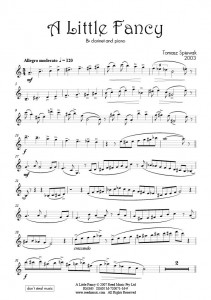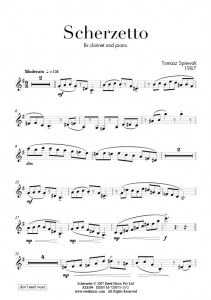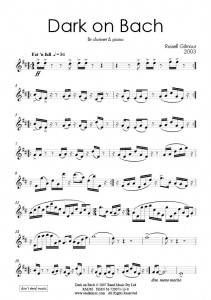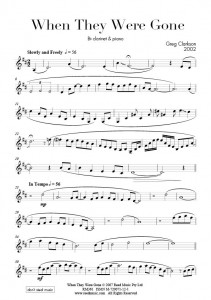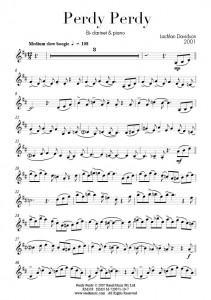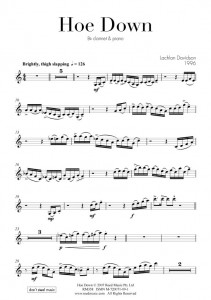Contents: Swing Thing, �Jewell in a Stone, �Cathy's Dream�, A Lane in Wales, �One Step at a Time, �A Good Time Was Had By All, �Duddles Chuckles, �Heritage
Swing Thing: This piece began life as an easy saxophone quartet but translates well to sax and piano. Be sure to play the longs and shorts accurately as it really helps it swing. Accent beat 2 and 4 for the same reason. When there is a quaver on the second half of a beat followed by a rest, it should always be short (staccato as marked) it is good to imagine that there is a note on the following beat to help place the last quaver.
Jewel in a Stone: Written for Julia, this is the most recently written of the tunes in Lokked in. Julia decided that she didn't feel like playing the C naturals that I had written so she played C sharps instead. I liked them so much that I changed the tune. There is much potential for some rubato and a very emotional performance of this piece. Some music turns out that way. Don't play it too slowly but don't hurry from one phrase to the next.
Cathy's Dream: Cathy had Chronic Fatigue syndrome at school and bravely fought through it. Her dream was to be healthy. I played this at her wedding recently where she seemed extremely well. The feel is Latin American influenced and the syncopations can be tricky. Very slow practice with the metronome, thinking in quavers and leaving the ties out can help gain an understanding of the rhythms. This is a good one to practise with the piano part slowly from the early stages of its preparation.
A Lane in Wales: In 1993, on a “round the world walkabout,” I visited my relatives in Wales and went on some long, solitary walks. This tune seems to capture the spirit of some of the lanes I walked along. I enjoy playing this tune and love the more classical feel of it. It suits a more classical sound and a softer dynamic. I love the sound of this piece at a slower tempo too. Be gentle but firm with it. Be aware of when the phrases are one, two or four bars long and be careful not to break it up too much.
One Step at a Time: Named for Steph, to motivate her to practise. Well it didn't work for her but it is a really fun piece to play with elements of rock in the eighties and a touch of David Sanborn. Thanks Dave.
Dig hard into the groove, the accents and the staccatos to really make it rock. A brighter sound and a generally stronger dynamic will suit this piece. The metronome is your best friend on this one.
A Good Time was Had by All: After a tour to Queensland with the school Stage Band, Yuki, a trombonist, asked me to write a piece for her VCE. I was honoured to do so and this was named as a celebration of the good time everyone had on the trip. It suits the saxophone just as well as the trombone and should be approached with a simple, not over-jazzy (or too cool) swing feel, emphasising the off-beat quavers and enjoying the fun in the music. The piano part really adds to the party so check it out as soon as you can.
Duddles Chuckles: I conceived this tune on the way home from a gig, named it after the unique laugh of one of my students, “Duddles” and arranged it for sax quartet before converting it to sax and piano. Play it with a bouncy swing feel in two, but emphasise (accent) the off-beats where quavers are slurred across the beat. There are some unusual staccatos which add to the character of the tune and make it less groovy or jazzy but more fun.
Heritage: I first took this tune (then un-named) to a gig at Bennetts Lane with unLokked (my jazz quartet) and subsequently recorded it on “A hot night in Burwood” released through Newmarket music. I consider it one of my best tunes. It has an obvious celtic influence but I know that Jan Garbarek and the Disney song, “Colours of the wind” were in the mix here too. This version is a simplified version of the original with far fewer ornaments than I would normally play but it still maintains its integrity and emotion. Play it with strength, commitment and honesty.







